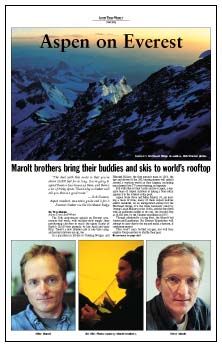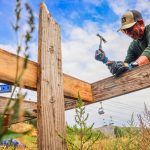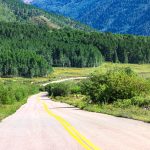Aspen on Everest
Aspen Times Staff Writer

“The deal with this route is that you’re above 28,000 feet for so long. You’re going to spend three or four hours up there, and there’s a lot of tricky spots. That’s why a climber will tell you this is a good route.”
– Bob Sloezen, Aspen resident, mountain guide and 3-for-3 Everest climber via the Northeast Ridge
The 50th anniversary assault on Everest commences this week, with military-style supply lines positioning climbers to reach the upper flanks of Earth’s 29,035-foot pinnacle by late April and early May. There’s a new Internet cafe at one base camp, and permit numbers are up, too.
In a paradoxical tribute to Tenzing Norgay and Edmund Hillary, the first summit team in 1953, the ups and downs of the 2003 spring season will unfold around a wartime world as they happen, including one planned live TV event starring an Aspenite.
But with skis on their backs and no oxygen, a separate team of Aspen climbers is taking a blue-collar approach to the whitest-collar peak.
Aspen twins Steve and Mike Marolt, 38, are leading a team of nine, many of them Aspen natives and/or residents, on an unsupported attempt for the Northeast Ridge. It’s the route famously plied by George Leigh Mallory in the 1920s, and the one fitted with an aluminum ladder at its crux, the Second Step at 28,600 feet, by the Chinese expedition in 1975.
Though admittedly a long shot, the Marolt-led American/Kazakhstan Ski Everest Expedition will attempt to carry skis to the top and make a descent, if conditions permit.
They won’t carry bottled oxygen, nor will they employ Sherpa porters to shuttle their gear.
It’s a notable departure from the customary routine, as Everest is dominated by guide outfits with longstanding formulas for success. Aspen’s Ted Mahon was selected to join such a team, under respected guide Russell Brice, as part of the Global Extremes TV event expedition.
But the mirror-image Marolts and company have sharpened their skills on 20 or so self-supported, oxygen-less expeditions to Alaska, the Himalayas and the Andes of South America. Mike Marolt remembers just one expedition when they didn’t bring skis along. That was in 1997 on Broad Peak in Pakistan, their first (and unsuccessful) attempt at an 8,000-meter peak, and he now wishes they had. “The retreat would’ve been easier,” he said.
The team has hopes for a summit, naturally, but it’s a secondary objective according to Mike, Steve and the others. Safety, fun, thrills and experience are primary and, naturally, coming home with fingers, toes and lifelong friendships intact.
Raised in Aspen with friends like Jim Gile, 39, and John Callahan, 40, the crew climbed the ladder of mountains, from nearby foothills to Fourteeners. Gile joined the Marolts in becoming the first North Americans to ski from an 8,000-meter summit, the central peak of Tibet’s Shishapangma, in May 2000, and Callahan is a former U.S. Cross Country Ski Team racer and 1992 Olympian.
Steve Marolt swears he was terrified the first time they tried to climb the Maroon Bells – passionately reinforcing this three separate times during an interview – but he did it, even if he had to be coaxed into it.
That same fear has been with him at every base camp ever since.
“Climbing Mount McKinley, that was going to be the last one,” said Steve. “I was like, `Man, if I can get to the top of Mount McKinley, that’d be so cool.’ Well, that happened and I was like, `I’m going to keep doing this. This is fun.’
“And you just naturally progress to the next step – but at any point in the progression, you can put the brakes on, say `I’ve had enough, I’m stopping here, I don’t need to do this anymore.’ It just so happens that through all these progressions in the past 25 years, this is going to be the culmination.”
Steve, like Mike, is an accountant. They went to college together in California, and they share an office in Aspen.
“How’s it feel two weeks out? I’m swamped with work, and I’m scared shitless!” Steve, feeling the crunch of tax time, said with a laugh.
“But it’s pretty normal for me to be scared because you don’t know what’s going to happen. Above 8,000 meters with no oxygen, not knowing how well you’re going to do, it’s scary. I think about it a lot. … And that’s the only way, with the anxiety and the fear that I have of climbing this peak, that I can actually get myself to go do this.”
The Everest expedition marks a break in form for the Marolts and Gile, now of Golden, the core group that has journeyed to distant peaks about once a year for the last 15 years. For starters, “there’ll be hordes of people on the north side,” said Mike – the Marolts are accustomed to solitude-by-design – and they’ll be using fixed ropes in contrast to their usual alpine-style approach.
Joining the Marolts, Gile and Callahan is the Marolts’ cousin, Jeremie Oates, a U.S. Army Special Forces captain currently living in Germany and teaching at a NATO school. Oates turns 33 on April 3, and he grew up in Aspen.
Warrant Officer, U.S. Army Special Forces, Tim Carlson, 43, of Woodland Park, is the other active-duty Green Beret on the team, with medical, mountain and winter warfare training. Carlson and Oates are former “A team” mates who became climbing partners.
Kevin Dunnett, 35, is an Aspen planner/landscape designer who’s been on a few recent training trips to the Andes with the team, and Dr. Jon Gibans, 44, is an emergency physician at the Snowmass Clinic with high-altitude climbing and rescue experience.
Roger Gocking, a climber the Marolts met on Broad Peak in 1997, joins the team from New York.
Additionally, the Marolts have raised funds for Kazakhstan climber Vadim Kaubluan, and possibly two other Kazakhs, to join them on the permit.
The cost of climbing Everest has been widely reported at sums taller than the mountain itself, but the Marolt trip is doing it on the relatively modest budget of about $10,000 per person. That will include two hired cooks at base camp.
Also on the mountain, but with different expeditions, will be Aspen resident Mahon and Aspen native Tap Richards. Mahon, 30, is one of five “winners” of the Global Extremes TV series, in which the finalists are teamed up for a guided Everest climb (which may also include Basalt’s Kent Harvey as cameraman). Richards, a professional guide who was on the team that found Mallory’s body on the down-sloping shingles below the Northeast Ridge in 1999, is leading a team from the south side for Washington-based International Mountain Guides.
Cabo San Lucas for spring break? No, thanks.
See you in Katmandu. All the local climbers disembark this week.
“We’ll touch the mountain and see how high we can get. That’s the goal,” said Steve.
“Route”-mentary
The Marolt team will follow the standard route on the Northeast Ridge, along with Mahon’s team, which means pitching in with other teams to share the expense for Sherpas to fix ropes on the upper mountain and even politicking for time and space to climb.
Starting in Katmandu, Nepal, the team will travel overland by truck across the border to Tibet and the 17,000-foot base camp. There, the acclimatization process begins in earnest as the team shuttles gear up the mountain, laying the physical and logistical groundwork to go ever higher, to advanced base camp at about 20,500. Then it’s upward to the North Col at 23,000, the first high camp.
From there the route is abundantly clear. The Northeast Ridge hovers 6,000 feet above, its fabled first, second and third steps guarding the summit in a left-to-right progression. The team plans to install two more camps, Camp II at about 25,000, then the 8,000-meter (26,340-foot) Camp III, high on the ridge in the so-called Yellow Band.
At 28,000 feet, the route traverses the north side of the ridge for nearly a mile – or two miles round trip – contouring up the final 1,000 feet to the summit in a series of steep snow ramps and rock bands, above one of the biggest walls in the world, the 10,000-foot true North Face.
“It’s rather exposed, certainly the most treacherous part of the route,” said Bob Sloezen, an international mountain guide from Aspen who successfully climbed Everest three times (1991, 1994 and 1998) via the Northeast Ridge. “It’s steep and loose, and there’s no purchase for your ice ax or crampons; loose, crumbly rock is flaking off beneath you.”
The crux of the route is the Second Step, where climbers must negotiate a rock chimney Sloezen rates a 5.7, up to a snow ramp and the infamously rickety Chinese ladder over a vertical headwall.
“I thought the Second Step was the ladder,” said Mahon, the Global Extremes participant from Aspen.
Like many of the climbers with the Marolt expedition, Mahon has consulted with Sloezen in recent weeks in hopes of gleaning details through conversation and photographs. The Marolts, who climbed with Sloezen on Broad Peak in 1997 and previously on Mount McKinley, call him their mentor.
“Without `Sloman,’ this whole Everest trip isn’t happening,” said Mike. “For better or worse, he’s the guy that has given us the ability to get out there and do this stuff on our own.”
For Mahon, Sloezen’s Everest slide show was a shocker.
“I always thought it was ascending fixed ropes on snow slopes; seeing some of the slides opened my eyes to what it is, thankfully. I’m glad I saw it before I got there,” he said.
“Knowing what the Marolts are doing, it makes me feel spoiled. … I’ll have tanks and tanks of oxygen and, supposedly, tea delivered to my tent at 7 o’clock every morning.”
Mahon learned he was going to Everest only weeks ago, after the last cut for the Global Extremes series in Iceland. After nine weeks on the road with the show, in Costa Rica, Africa and Iceland, he returned home to Aspen for two weeks to prepare for the 10-week expedition.
The Marolts, meanwhile, have been planning their expedition for almost three years. They postponed it last spring, due to war in Afghanistan and reverberating instability in the region, only to see a record number of climbers reach the top of the world anyway.
Of the two well-traveled trade routes on Everest – the South Col being the other – the Northeast Ridge is the more difficult, with sections of technical mixed climbing on the upper mountain. But what the Northeast Ridge demands technically and physiologically, with longer exposure to extreme altitude, it makes up for in lesser objective danger. The south side’s Khumbu Icefall, a harrowing passage through an ever-advancing glacial flow, is the only way in.
`Ultraconservative’
The Marolts, a fourth-generation Aspen family, have made innovative ski tracks for decades. A Marolt skied Highland Bowl in the 1930s; the Marolts’ uncle, Bill, runs the U.S. Ski Team and their dad, Max, was an Olympic ski racer. Now the Marolt twins are hoping to become the first North Americans to ski on Everest.
It’s a “first” first completed by Italian Hans Kammerlander in 1996. Kammerlander set a speed-ascent record by summiting via the Northeast Ridge without oxygen – 16 hours, 45 minutes from the 6,400-meter base camp to the top (since broken). Then he skied most of the way down. Several sections were unskiable for Kammerlander then, and the Marolts expect a similar scenario next month.
They are planning to rappel down the Steps and down-climb the Yellow Band on the way back to the North Col. If they get skis to the top, they’ll ski where they can.
“A lot of people think we’re arrogant for not taking oxygen and taking the skis,” said Steve.
“And they thought we were arrogant for taking the skis to `Shish,'” added Mike.
“But that’s the thing that drives us,” Mike continued. “It’s a total adventure, it’s going to see – I’ve been to 8,000 meters, I want to take it to the next level and personally see what it’s like. That’s not to slam anybody who’s climbed it with oxygen, I mean to each his own, but our philosophy is that we have absolutely zero desire to attempt Mount Everest with oxygen.
“But on the same token, I know it’s a tall order,” he admitted.
“There’s not a lot of snow up there, and what snow there is, is probably ice, so the ski thing is such an incredible long shot. … But so what? It’s a fun dream, it’s fun to chase it.”
It’s difficult to pinpoint the number of climbers who have summited Everest without supplemental oxygen, but it’s clearly a fraction of the total that now numbers more than 1,200.
Again, that’s the challenge, the reason, the great unknown.
“People think we’re these big-name professional climbers that are just gung ho on taking it to the next level for the sake of the feather, and I just don’t even care. I just want to have a good trip, and a good trip means everybody stays healthy, everybody has fun,” said Mike.
“I can tell you I’ll do some skiing on Everest, but I’m not going to lose toes, I’m not going to go up there and get myself in trouble just because I’m hell-bent on some jewel that’s pretty much impossible to obtain anyway. … It’s fun, it’s exciting, it’s neat to be at 8,000 meters; that’s the philosophy everybody has.”
John Callahan’s dad, John Sr., who lives in Aspen, served with Mountain Rescue Aspen when his boys were growing up. Early on, he exposed the youngsters to the harsh realities of mountaineering, fostering an “ultraconservative approach.”
“Dad always had a quote, and I’m sure it can’t be attributed to him, but it’s `Nobody that we ever pulled off a mountain went up there thinking they were going to die that day,'” said Callahan, a computer programmer for Deer Valley Resort who lives in Park City.
“Frankly, I’ll be surprised if we get a guy with skis to the top of that mountain,” Callahan continued. “Without oxygen, without Sherpas, that already makes it a difficult venture in the first place. … But you never know. If the opportunity presents itself, we’ll take advantage of it.”
As is the case on any mountain – and the ocean, desert or jungle, for that matter – nature plays no favorites. Over the years, Everest has claimed some 175 lives.
“What I’m doing is a fairly selfish thing just by going,” added Callahan, who has five children with his wife Kathleen – a 16-year-old daughter, a 7-year-old son and 5-year-old triplets, two boys and a girl.
“I really need to take all the steps I can to make sure I come home and make sure my kids have a dad in June.”
Mike Marolt and his wife, Shelly, also have a daughter, 15-month-old Talulah. Oates and Gile each have two children, and Carlson has an infant son.
“I’ll go as high as I comfortably can,” Callahan continued, “and that’s when I turn around; I’ll be support on the lower mountain. If it gets to the point where it’s too scary, I’m turning around.”
It’s a sentiment loudly echoed by others on the expedition.
How high?
Experts say genetics, not conditioning or preparation, is the key to success at high altitude. At the same time, altitude sickness can strike even seasoned vets of 8,000-meter peaks and shows little mercy for those who climb too quickly and forgo the slow acclimatization process.
Mike, Steve and Jim have all been to 8,000 meters on Shishapangma and Broad Peak, along with Gibans on a separate oxygen-less ascent of Gasherbrum II in 1994, but no one on the team has gone higher.
The team hopes to establish three high camps above advanced base camp to facilitate a summit push, hopefully growing accustomed to the altitude with each load carried, each rest day back at lower elevations.
“I know I’ll get the `Khumbu cough,’ and you’re not getting rid of it until you come down, way down, but my goal is to stave it off as long as I can,” said Gibans, who has served as a volunteer with the Himalayan Rescue Association and the Denali (Mt. McKinley) Ranger Patrol. “And that’s really hard, especially when you’re climbing, working awfully hard to get the camps in.”
The prevalent cough isn’t symptomatic of altitude sickness, Gibans said – “It’s a dry cough compared to a wet one, nothing to do with edema” – but it adds to the suffering.
“I’ve seen people who haven’t done their homework, and they get themselves into trouble,” Gibans said. “People with the summit-or-die mentality. But being a group where it’s not the final word, and people are working toward a common cause, hopefully we’ll have safety and judgment on our side. Of course, it’s always easier to say that here.”
Unlike the rest of the Marolt team, Gibans plans to carry a supply of bottled oxygen. “Initially, they decided it was against the grain of the trip, but I don’t have any desire to try it without it. … That was the choice, and they wanted a doctor along.”
In addition to Gibans, the team is fortified with the expertise of Special Forces officers Oates and Carlson, each with 10-plus years of service in the Army.
Carlson, a medic with two years of medical school training in advanced trauma and advanced cardiac treatment, serves in the 10th Special Forces group based in Fort Carson in Colorado Springs. He teaches a course in mountain and winter warfare and completed the two-year German Military Mountain Course near Garmisch, one of a handful of Americans to do so.
Oates and Carlson were granted leave for the expedition several years ago, well before war in Iraq.
“It’s part of our training, to validate our training program for Special Forces,” Carlson said. “Obviously, if we can successfully climb Mount Everest, our training program for instructors, as well as our students, should be pretty good. That’s the way we sold it.
“Unfortunately, it happened to coincide with the political events happening in Iraq. It probably wouldn’t have been a problem to get it approved otherwise, although it is risky. But the Army has been very supportive of sending us on this expedition, in spite of the fact that numerous other missions are going on in other parts of the world.
“What happens when we get back is another story. We could be emptying our rucksacks and repacking them for someplace else.”
During the expedition, the team will carry a satellite phone to relay dispatches for posting on the Internet at http://www.everestnews.com. They plan to file daily entries as they work their way up the mountain over a two-month span.
“The goal on a trip like this is the next camp,” said Mike. “Yeah, we want to get to the summit, and I think if all goes well some of the guys on this team have the ability to get to the summit without porters and without the oxygen – I know they do – but it is such a tall order that you have to make the goal within your reach that you know of. In this case, it’s 8,000 meters.”
In the meantime, as Sloezen has said, an often-overlooked element to high-altitude expedition climbing is a climber’s knack to make the most of his down time, refueling and recharging at lower elevations. In Sloezen’s words, it’s the ability to be a great “hanger-outer.”
Kevin Dunnett, the self-described “rookie” of the group – whose nickname “Backwoods” refers to his rural Vermont roots – says he’s confident of the team’s strength in this arena.
“There’s no better entertainment than being on a trip with Steve and Mike Marolt,” said Dunnett. “Pure entertainment 24-7; great guys to be stranded in a snowstorm with, them and their stories. You can be in the most desolate place on earth, laughing uncontrollably for hours.
“Of course, I don’t think this whole thing is really going to hit me until I stand in front of it. It’s huge, you know. Things just might not be as funny when I face it.”
Tim Mutrie’s e-mail address is mutrie@aspentimes.com.
Trial dismissed, all charges dropped for former Aspen coach
Over 60 prospective jurors filed out of the Pitkin County Courthouse on Monday morning after former Aspen High School Assistant Basketball Coach Chris Woodring saw his trial dismissed and his charges dropped.









